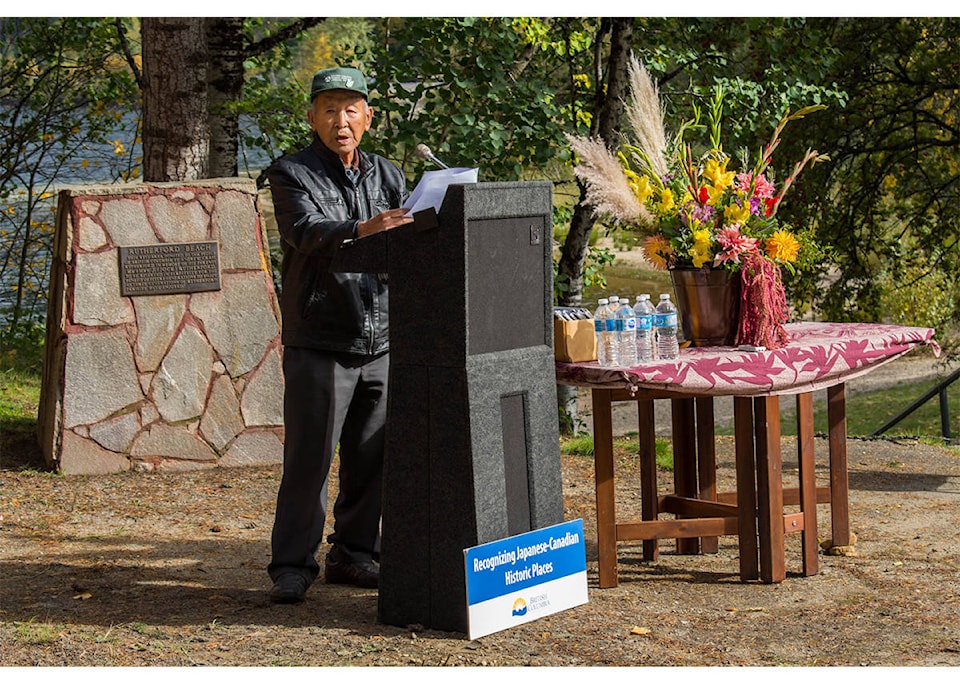The microphone crinkles and cracks as Stony Nakano addresses the crowd. Government ministers, First Nation Chiefs, and school children sit or stand in long rows. Listening. Golden leaves shiver and dance in the breeze as Nakano speaks. Every so often, semi trucks rumble past on the highway but Nakano’s voice is steady, clear and unwavering. He’s been waiting a long time for this moment.
Behind Nakano is a large wooden sign, the last of eight to be unveiled around the province. This project grew out of a partnership between the Ministry of Transportation and Infrastructure and the Japanese Canadian Legacy Committee to commemorate the 75th anniversary of Japanese internment by the Canadian government.
The unveiling took place near Three Valley Lake Chateau, roughly 24 km west of Revelstoke on Sept. 28.
READ MORE: New Signs to mark Japanese internment camps in Shuswap
Fearing a Japanese invasion the Canadian government from 1942 to 1949 detained 22,000 Japanese Canadians. They confiscated their homes, businesses, and properties to help pay for detainment. Japanese Canadians became prisoners within their own country.
Up to 1,700 men were separated from their families and sent to road camps to build highways that were deemed priority for national security. Nakano was sent to the Griffin Lake Road Camp to build part of the Trans-Canada Highway.
“What happened to our family during the war years was unjust and grew out of racism,” says Nakano.
Other roads in B.C. built by Japanese Canadians include Highway 3 (Hope to Princeton) and Highway 5 (Yellowhead to Blue River).
“It was difficult work, treacherous and under very poor conditions,” says B.C. Minister of State for Trade George Chow.
The men were paid 20 cents a day.
“These signs help to tell the story of the thousands of Canadian Japanese that wrongfully had their homes and businesses confiscated,” says Chow.
If there was protest, the Japanese Canadians were sent to prisoner of war camps.
| The sign describes the work camps and where they were located. They aim to educate the public on a dark period in Canada's history. |
“Before the war, Japanese Canadians were not allowed to live within the City of Revelstoke, simply because they were Japanese,” says Chow.
These signs show a dark part of Canada’s past with an aim to educate.
“Today our dream has come true. History will not be forgotten,” says Laura Saimoto from the Japanese Canadian Legacy Committee. Her voice cracking with emotion.
“We must never allow such racism to happen again in Canada or the world.”
Nakano acknowledged that internment was particularly difficult for his father.
“For my dad, he cleared his own land. And he got it all taken away. He didn’t get any apologies. I feel sorry for my dad.”
Nakano’s father died in the 1970s, long before the Canadian government publicly apologized for internment in 1988.
| The Griffin Lake Roadcamp. This was where Stony Nakano was sent (Submitted by Nikkei National Museum and Cultural Centre). |
“I have five children all doing well, 10 grandchildren, and eight great grandchildren. I’m very proud of them. We brought them up good, none of them got into trouble.”
Nakano travelled from Hamilton, Ontario for the unveiling. He says this will probably be his last time out west.
| More than 100 people came for the unveiling. |
READ MORE: Japanese Canadian recounts life in B.C. internment camp
Nakano and Nakazawa have returned to where, 75 years earlier, they forcibly toiled building Canada’s main artery of transportation.
| A Japanese garden and hand built torii gate at Three Valley Gap Road Camp 1943 (Submitted by Nikkei National Museum and Cultural Centre). |
“The men made most of the situation. The situation didn’t make the most of them,” concluded Chow.
@pointypeak701
liam.harrap@revelstokereview.com
Like us on Facebook and follow us on Twitter.
